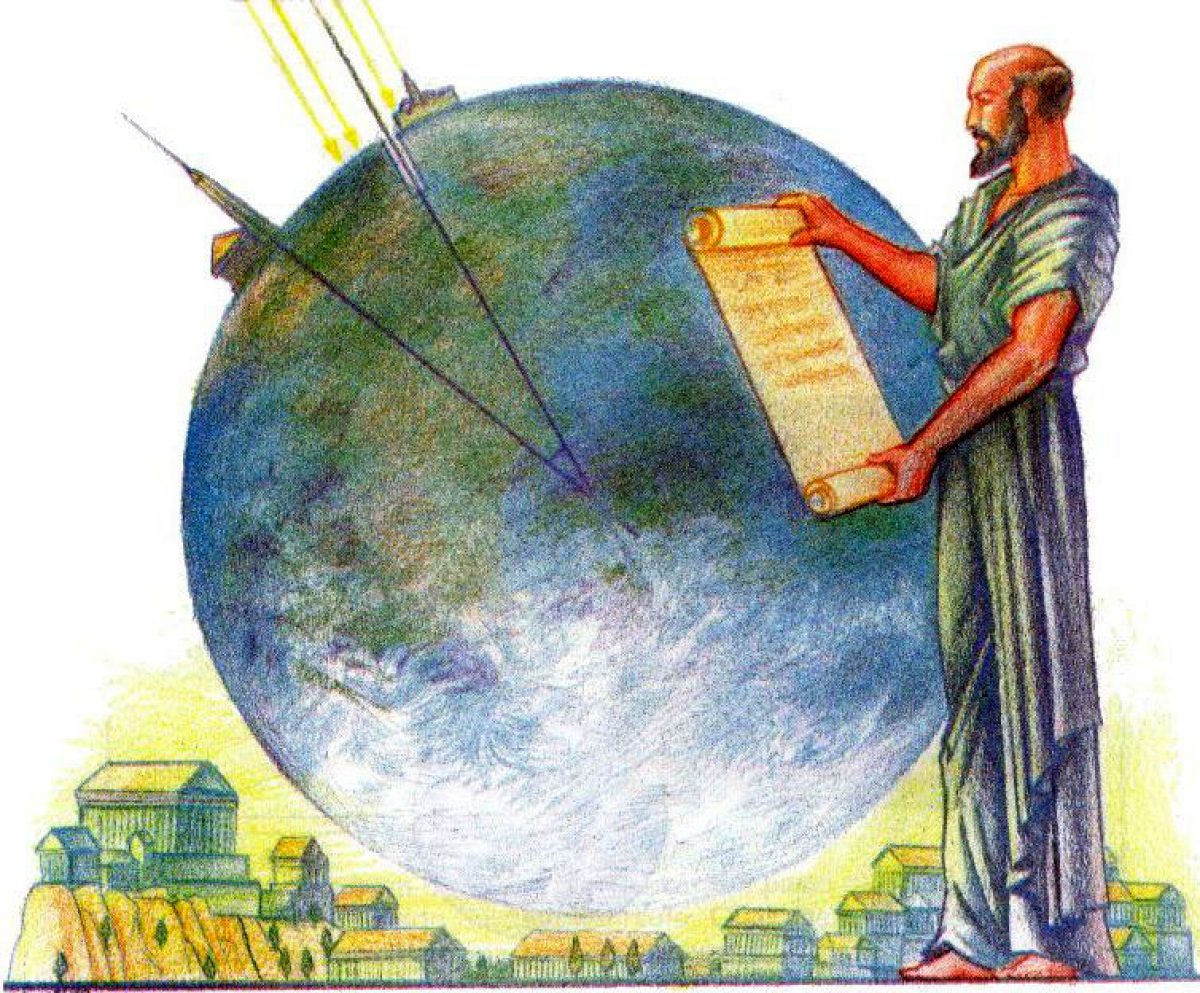Eratosthenes and the discovery of the circumference of the Earth, by unknown artist
"By the fifth century BCE, the Greeks had firmly established that the earth was a sphere. Although they knew it was a sphere, they didn't know how big the sphere was.
The philosopher Plato (400 BCE) declared the earth's circumference to be 64,412 kilometers (40,000 miles). Some 150 years later, the mathematician Archimedes estimated it to be 48,309 kilometers (30,000 miles). It's not known exactly how Plato or Archimedes arrived at their calculations, but Plato's measurement was off by sixty percent and Archimedes' by twenty percent. At least they were making progress.
Observations and calculations by two later Greeks, Eratosthenes and Posidonius, finally resulted in accurate estimates of the size of the earth.
In the third century BCE, Eratosthenes, a Greek librarian in Alexandria, Egypt, determined the earth's circumference to be 40,250 to 45,900 kilometers (25,000 to 28,500 miles) by comparing the Sun's relative position at two different locations on the earth's surface. Because of differences in translations or interpretations of his records, and his own methodological errors, the exact figures are in dispute. Today, the earth's circumference is usually accepted to be 40,096 kilometers (24,901 miles). If you take the lowest estimate attributed to Eratosthenes, his error was less than one percent—a phenomenal calculation.
Eratosthenes determined the earth's size by observing known phenomena and applying basic arithmetic and geometry to them. Here's how he did it.
While in Syene, Egypt (known today as Aswan), he noticed that the sun's rays shone directly down a well, casting no shadow at all. From this, he concluded that the sun was directly overhead at Syene. On the same date in Alexandria, a rod perpendicular to the ground cast a shadow that was 7° 12' from perpendicular.
Eratosthenes then divided 360° by 7° 12' and determined that 7° 12' was 1/50th of a circle. Now all he had to do was find the distance from Syene to Alexandria and multiply it by 50 to get the earth's circumference.
Many scholars believe Eratosthenes measured the distance by measuring a single pace and then counting the number of paces from Syene to Alexandria. While this is possible, it is just as likely that he counted the revolutions of a wheel with a known circumference, since this was a common method of measurement in both Egypt and Greece. Either way, he probably hired someone or enlisted a slave to accomplish the task. The distance figure he used was 805 kilometers or 500 miles.
Next, he multiplied this distance by 50 to get 40,250 kilometers (25,000 miles). Today, most scientists set the earth's circumference at 40,096 kilometers (24,901 miles). This gives Eratosthenes' estimate less than a one percent error—an excellent approximation of the earth's circumference.
Posidonius used the stars to determine the earth's circumference. He observed that a given star could be seen just on the horizon at Rhodes. He then measured the star's elevation at Alexandria, Egypt, and calculated the angle of difference to be 7.5 degrees or 1/48th of a circle. Multiplying 48 by what he believed to be the correct distance from Rhodes to Alexandria (805 kilometers or 500 miles), Posidonius calculated the earth's circumference to be 38,647 kilometers (24,000 miles)—an error of only three percent. The exact details of his methods are not known, but we do know the distance he used was incorrect and the fact that Rhodes is not due north of Alexandria would result in computational errors. Although his measurements were flawed, he was lucky because the errors canceled themselves out and he arrived at a fairly accurate calculation of the earth's circumference.
In the second century CE (Common Era) in Alexandria, a philosopher named Claudius Ptolemaeus, or Ptolemy, revised Posidonius' calculations and set the earth's circumference at 28,985 kilometers (18,000 miles)—an error of nearly 28 percent. Because of Ptolemy's contributions to geography and cartography, his circumference was used throughout the Renaissance. It is believed that Christopher Columbus used Ptolemy's number to plan his voyage to the Far East. Everyone knows how that voyage ended—Columbus bumped into a continent that was hiding in the 28 percent error."
-taken from cuny.edu
 |
| Eratosthenes and the discovery of the circumference of the Earth, by unknown artist. |
 |
| "Eratosthenes' methods were simple but effective. All he needed to know was the distance between two locations and what percentage of a circle this distance constituted." |
Source:
Quote:




And Christianity destroyed all this knowledge and the entire scientific tradition of the Mediterranean, and all for the salvation of the Jews.
ReplyDelete